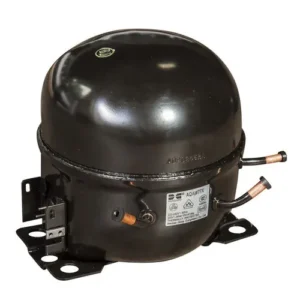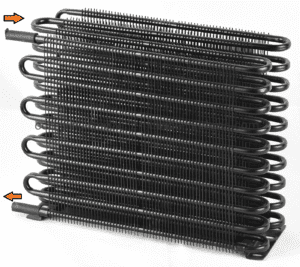Domestic Freeze or Refrigerator
- Refrigerators work by using refrigerant which circulates inside the coils
- It changes from a liquid to a gas. This process is called evaporation cooling
- The most refrigerators temperature is kept between 0 to 5 degrees Celsius ( -9 to 0°F) for maintaining fresh vegetables
- Some freezer-only units can operate at lower temperature of −34 °C (−29 °F) and lower as per need of their purpose.
- Food items are placed in various compartment of refrigerators
- Freezer section (lowest temperature) for ices making
- The doors side space for cold-drinks
- Upper shelves for vegetables
- Lower shelves for raw vegetables
- Crisper drawers.
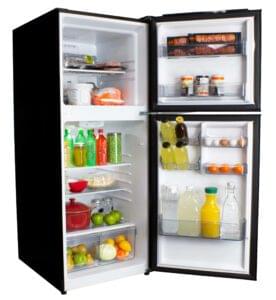
- Before using the refrigerators, we have to understand working principle of refrigerators considering electric safeties
How does the home refrigerator work?
- A coolant is used to absorb heat from the food to be cooled
- The coolant is initially compressed by the compressor, which heats it up
- The hot coolant is then passed through the condenser coils at the back of the fridge, where the heat is dissipated. The coolant then passes through the expansion valve, where it expands and becomes a cold gas
- The low-temperature coolant absorbs the heat from objects and then the heated coolant releases heat on the back side of in the condenser coil of the freeze
Simple Refrigeration Cycle
Basic Components of a Refrigeration System
The main components of a vapor-compression refrigeration system are:
- Evaporator: Where heat is absorbed, cooling the surrounding space.
- Compressor: Compresses the refrigerant gas, raising its pressure and temperature.
- Condenser: Releases heat to the surroundings, turning the refrigerant back into a liquid.
- Expansion Valve: Reduces the refrigerant’s pressure, cooling it and allowing it to flow back to the evaporator.
The working fluid is coolant and it passes through the evaporator, condenser, expansion coil and refrigeration chambers
- Compressor
- Condenser
- Evaporator
- Capillary tube
- Thermostat
- Capacity control system
- Receiver
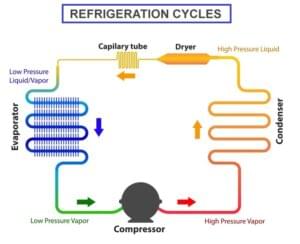
Working principle of refrigeration cycle
The working principle of a refrigerator is based on the transfer of heat from a low-temperature environment (inside the refrigerator) to a higher-temperature environment (outside the refrigerator). This process is achieved through a combination of several components and thermodynamic principles. Here’s a simplified explanation of how a refrigerator works:
- Refrigerant:
- The refrigerator uses a refrigerant, a substance with properties that allow it to absorb and release heat efficiently.
- The most commonly used refrigerants are hydrofluorocarbons (HFCs) or hydrochlorofluorocarbons (HCFCs).
- Compression:
- The process begins with a compressor, which is usually located at the back of the refrigerator.
- The compressor’s role is to compress the refrigerant gas, increasing its pressure and temperature. As a result of compression, the molecules in the gas become closer together, and their energy (temperature) increases.
- Condensation:
- The high-pressure, high-temperature refrigerant gas then flows into the condenser coils, located either at the back or underneath the refrigerator. The condenser coils are designed to dissipate heat efficiently.
- As the hot refrigerant gas flows through the coils, it comes into contact with the cooler air in the room or the outside environment.
- The heat from the refrigerant is released to the surroundings, causing the refrigerant to condense into a high-pressure liquid.
- Expansion:
- The high-pressure liquid refrigerant then moves through a small opening called the expansion valve or capillary tube.
- This valve restricts the flow of the refrigerant, causing a pressure drop.
- As a result, the refrigerant expands rapidly, leading to a decrease in pressure and temperature.
- Evaporation:
- The low-pressure, low-temperature refrigerant then enters the evaporator coils, which are usually located inside the refrigerator. The evaporator coils are in direct contact with the air inside the refrigerator.
- As the warm air from inside the refrigerator passes over the cold evaporator coils, heat is transferred from the air to the refrigerant. This causes the refrigerant to evaporate, transforming it back into a low-pressure gas.
- Absorption of heat:
- As the refrigerant absorbs heat from the air, it cools down the air inside the refrigerator, creating a cold environment for storing food and other items.
- Circulation:
- The compressor then draws the low-pressure gas back into the system, starting the process over again.
- This continuous circulation of the refrigerant allows the refrigerator to maintain a cool temperature inside while transferring heat outside.
- By continuously repeating these steps, a refrigerator can maintain a cool internal temperature, keeping food fresh and preserving its quality.
- The process of heat transfer and refrigerant circulation is what enables the refrigerator to extract heat from the inside and release it outside, thereby cooling the contents of the refrigerator.
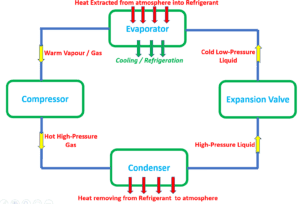
- When food items are kept in the fridge, the cool refrigerant is passed.
- The heat from the food items is absorbed by the refrigerant.
- The heat absorbed by the refrigerant gets transferred to the relatively cooler surroundings outside.
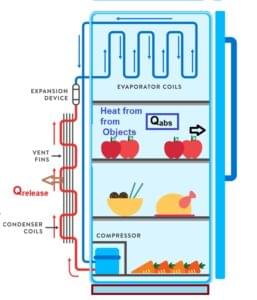
- The cooling fluid is passed through the expansion coils inside the fridge and its pressure dec
The Refrigeration Cycle Steps
The vapor-compression cycle has four main steps:
Step 1: Evaporation (Cooling Process)
- Refrigerant in the Evaporator: A low-pressure liquid refrigerant enters the evaporator. Inside the evaporator, it absorbs heat from the surroundings (for example, inside a refrigerator).
- Heat Absorption and Phase Change: As the refrigerant absorbs heat, it evaporates and changes from a liquid to a vapor. This evaporation process absorbs heat from the air inside, cooling the area.
Step 2: Compression (Increasing Temperature and Pressure)
- Compressor Action: The compressor draws in the low-pressure refrigerant vapor from the evaporator and compresses it, raising its pressure and temperature.
- High-Temperature, High-Pressure Vapor: This high-pressure, hot vapor then flows from the compressor to the condenser.
Step 3: Condensation (Heat Rejection)
- Heat Release in the Condenser: The high-temperature vapor enters the condenser coils, where it releases heat to the surroundings (usually outside the refrigerated space).
- Phase Change Back to Liquid: As it cools, the refrigerant condenses back into a high-pressure liquid. The heat released during condensation is expelled, typically by a fan or natural convection.
Step 4: Expansion (Cooling and Pressure Reduction)
- Expansion Valve Process: The high-pressure liquid refrigerant flows through an expansion valve or capillary tube. This valve allows the refrigerant to expand, reducing its pressure and temperature significantly.
- Low-Pressure, Cold Liquid: The cold, low-pressure refrigerant flows back to the evaporator, ready to absorb heat again and repeat the cycle.
Key Concepts in Refrigeration
- Latent Heat of Vaporization: The key to refrigeration is the absorption and release of heat as the refrigerant changes phase (liquid to vapor in the evaporator and vapor to liquid in the condenser).
- Heat Transfer: The cycle relies on transferring heat from inside the cooled space to the environment outside it.
- Refrigerant Properties: Refrigerants are selected based on properties that allow efficient heat absorption and release at manageable pressures.
Alternative Refrigeration Methods
In addition to vapor-compression, there are other refrigeration methods:
- Absorption Refrigeration: Uses a heat source (like gas or solar energy) instead of a compressor.
- Thermoelectric Cooling: Based on the Peltier effect, where electric current creates a temperature difference across materials.
Major Parts of Freeze
The details of the components are mentioned below
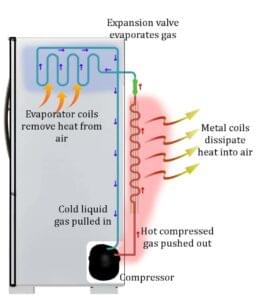
Evaporator
- The evaporator in the refrigerator is located inside a fridge and makes the items in the refrigerator cold.
- It removes the unwanted heat from the food items through liquid refrigerant.
- The pressure of the liquid refrigerant must be low.
- Two variables decide the low pressure- first, heat gets absorbed from the product to the liquid refrigerant and the second one is the removal of air pressure by the compressor.
- Through evaporation, the refrigerant turns liquid into a gas and cools down the area. Hence, it produces the appropriate environment for storing and preserving food.

Compressor
- The compressor and the electric motor are kept in a single enclosed container
- A reciprocating type compressor is generally used in the fridge
- It is used to increase the pressure of refrigeration and keep the recirculation of coolant.
- The compressor can make the refrigerator hot by putting pressure on the warm part of the circuit.
- It consists of an electrical motor that sucks in the refrigerant from the evaporator and compresses it to make a hot and high-pressure gas (coolant).
- It helps to compress and convert low-temperature to high temperatures.
- Cross section of compressor is shown below
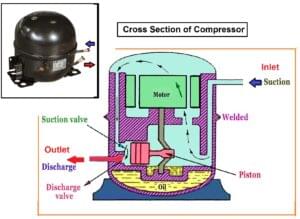
Condenser
- It is placed in the rear of the fridge.
- It is useful to extract heat from the refrigerant.
- It cools down the refrigerant and changes the matter. That means it changes gas back into liquid. This is the refrigerator cooling system.
- To remove from the condenser coil, fans above the condenser unit draw air over the condenser coils
- The desired range of temperature of condensation: -15 degrees to -1 degrees C
- The coolant vapor cools down to form a liquid refrigerant.
Expansion coils (Capillary tubes)
- It is an expansion coil and consists of a thin piece of tubing.
- The liquid refrigerant is routed through the capillary coils and distributed into the low-pressure environment of the evaporator.

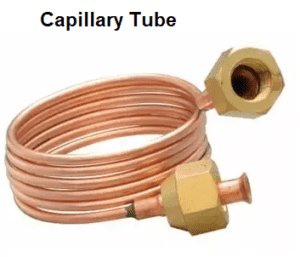
Thermostat
- It is a knob that adjusts the temperature setting
- The thermostat helps to control the cooling process in the fridge by monitoring the temperature and switching the compressor on and off.
- When an object is cold enough inside the fridge, the sensor can sense that and turn off the compressor.
- When it senses too much heat, it switches the compressor on, and the cooling process begins again.


Capacity control system
- It regulates the power and energy consumption
- It manages dehumidification and decreases compressor cycling.
- It has an on/off option, which is the simplest form of capacity control.
Receiver
- The receiver acts as a vapor seal.
- These are made for both horizontal and vertical installation.

Refrigerant Used in Refrigerator
n household refrigerators, the most commonly used refrigerants are hydrofluorocarbons (HFCs) or hydrochlorofluorocarbons (HCFCs). The specific refrigerant used can vary depending on the age and type of refrigerator. Here are a few examples:
R-134a:
- This HFC refrigerant has been widely used in refrigerators and air conditioning systems.
- It has a relatively low global warming potential (GWP) compared to some older refrigerants.
R-410A:
- Another HFC refrigerant is commonly used in newer refrigeration and air conditioning systems.
- It is known for its high energy efficiency and is often used as a replacement for older refrigerants like R-22.
R-600a
- This is a hydrocarbon refrigerant, specifically isobutane.
- It is becoming increasingly popular due to its low environmental impact and excellent energy efficiency. R-600a is commonly used in newer refrigerators, especially in Europe and many other regions.
How to select Refrigerant
- It’s worth noting that there has been a global effort to phase out high-GWP refrigerants, including HFCs and HCFCs, due to their contribution to climate change.
- As a result, there has been a shift towards using more environmentally friendly refrigerants with lower GWP, such as hydrofluoroolefins (HFOs) and natural refrigerants like carbon dioxide (R-744), ammonia (R-717), and hydrocarbons.
- The specific refrigerant used in a refrigerator can vary depending on factors like the manufacturer, model, and regional regulations.
- It’s always best to refer to the refrigerator’s documentation or contact the manufacturer for the specific refrigerant used in a particular appliance.
- Here are some considerations for each type:
- Choosing between a single-door and a two-door refrigerator depends on various factors such as the size of your family, available space, and your specific needs.
- Storage Space:
- Two-door refrigerators generally offer more storage space than single-door ones.
- If you have a large family or frequently store a lot of food items, a two-door refrigerator might be more suitable as it provides separate compartments for fresh food and frozen items.
- Energy Efficiency:
- Modern refrigerators, both single-door and two-door, come with energy-efficient features.
- However, two-door refrigerators with separate cooling systems for the fridge and freezer compartments may be more energy-efficient in the long run, as you can open just one section at a time, reducing temperature loss.
- Convenience:
- Two-door refrigerators offer the convenience of easily accessing fresh and frozen items without affecting the temperature of the other compartment.
- This can be beneficial for organizing food items and accessing them quickly.
- Space Constraints:
- If you have limited space in your kitchen, a single-door refrigerator might be a better fit as it generally takes up less floor space compared to a two-door model, especially if the two-door refrigerator is larger in capacity.
- Budget:
- Generally, single-door refrigerators are more budget-friendly compared to two-door models with similar features and capacity.
- If budget is a concern, a single-door refrigerator might be a more economical choice.
- Storage Space:
Single Door Refrigerator:
-
- Suitable for small to medium-sized families.
- Compact design, making it ideal for kitchens with limited space.
- Generally more energy-efficient compared to larger models.
- Limited freezer space, usually a small freezer compartment inside the main refrigerator section.
Two-Door Refrigerator (Top Freezer or Bottom Freezer):
-
- Ideal for medium to large families or households that need more storage space.
- Separate compartments for fresh food and frozen items, providing more storage flexibility.
- Bottom freezer models offer easier access to fresh food items without bending down.
- Generally, consume more energy compared to single door models due to their larger size.
Major issues in Refrigerator
- Due to long use or poor maintenance, you may face practical issues in refrigerators. You can refer the post on this site.
- The cost can be reduced by regular maintenance costs. Major problems are also discussed in the posts.
- Some common Problems need to fix in time in your refrigerator
-
- Cooling problem
- The buildup of Frost in the Ice Dispenser.
- Ice Maker is not working
- Freezer not too cold
- High Cycling of the refrigerator
- The Fresh Food Compartment is not cold
- Sheet of Ice on the Freezer Floor.


